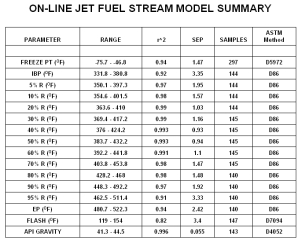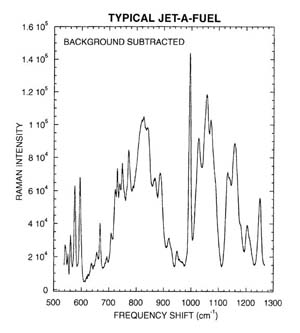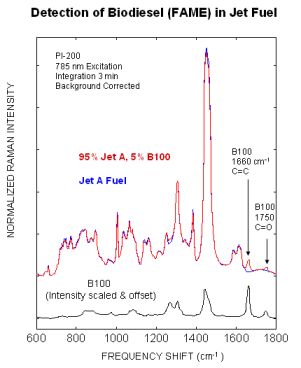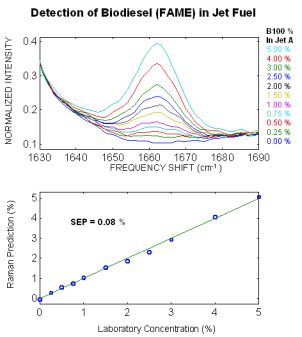Quick Menu
Jet Fuel Monitoring
Typical Jet Fuel Properties Measured with Process Instruments Raman:
- Freeze Point
- Distillation Points
- Flash Point
- API Gravity
- Naphthalene Content
Since aromatics are very strong Raman scattering compounds, we recommend measuring both smoke point and JFTOT.
Typical online results for a jet fuel stream. The low standard error of prediction (SEP) between the laboratory minus the Raman predicted values show that our Raman analyzer can reliably model critical parameters. ASTM methods used for the laboratory analysis are displayed in the far right column.
Detection of Biodiesel in Jet fuel
Biodiesel is a renewable diesel fuel that is also known as FAME (fatty acid methyl ester) in the European Community. Spectra of a jet fuel and the same fuel containing 5% biodiesel (FAME) are displayed to the right. An intensity scaled biodiesel spectrum is also displayed for reference. The two dominant biodiesel peaks at 1660 cm-1(C=C) and 1750 cm-1 (C=O) are easily detected in a jet fuel spectrum, and can be used to determine the amount of biodiesel (FAME) in jet fuel.
The spectral responses from trace concentrations of biodiesel (FAME) in jet fuel are displayed to the right (upper figure). The observed spectral responses were initially background corrected. A standard PI-200-L spectrograph was used for this study. Comparisons between the actual and predicted biodiesel concentrations in jet fuel are displayed in the lower figure to the right. The Raman predictions were determined from the 1660 cm-1 (C=C) peak heights, and the standard deviation from the (actual – predicted) concentrations was 0.08 vol%. Lower detection limits, down to the 1000 ppm range, could be easily obtained by using our high performance CCD, increasing laser power, or increasing the sample integration time.




